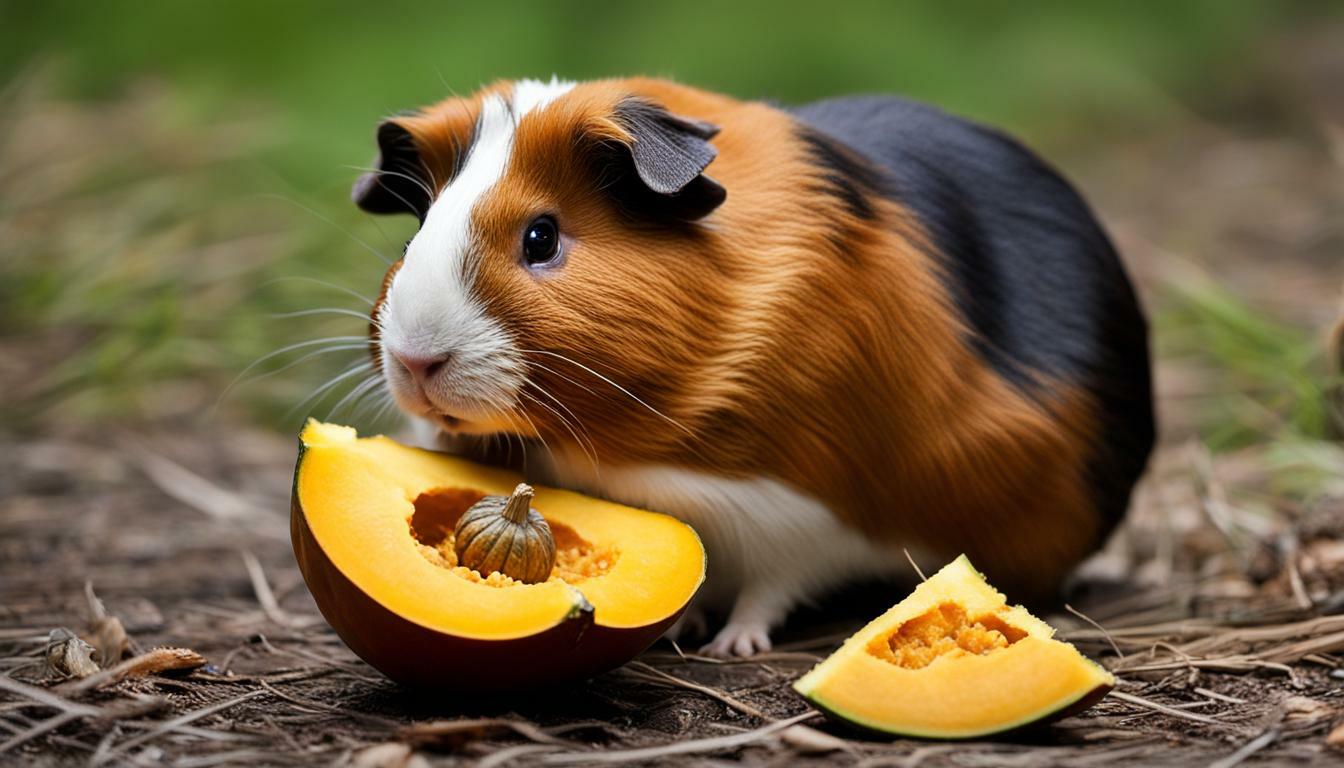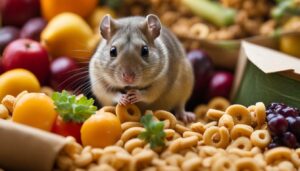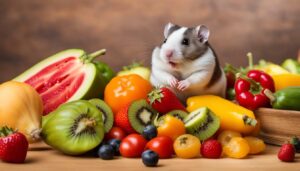Are you wondering if it’s safe for your guinea pig to enjoy some delicious acorn squash? Guinea pigs can safely eat acorn squash, a nutritious winter squash that offers several health benefits. However, there are some important guidelines to follow to ensure your guinea pig’s safety and well-being.
Key Takeaways:
- Guinea pigs can safely eat acorn squash, but only the flesh.
- Avoid feeding guinea pigs the stem, skin, seeds, and stringy parts of the acorn squash.
- Acorn squash is rich in essential nutrients, including vitamin A, vitamin C, potassium, manganese, and magnesium.
- It supports the immune system, digestion, bone health, vision, and coat condition of guinea pigs.
- Feed acorn squash to guinea pigs in moderation, with a recommended serving size of around 3 ounces (100 grams) and 2-4 times per week.
- Do not add any butter or spreads to the acorn squash when serving it to guinea pigs.
- Store acorn squash in a dry place, refrigerating it once it’s cut, and watch out for signs of spoilage, such as black spots, dents, and gray seeds.
Understanding Guinea Pig Diets
Before we dive into the specifics of feeding acorn squash to your guinea pig, let’s understand the basics of their diet. Guinea pigs are herbivores, which means they primarily eat plant-based foods. Their diet consists of hay, fresh vegetables, and in smaller amounts, pellets and fruits. It’s important to provide a balanced and varied diet to ensure their nutritional needs are met and to promote their overall health.
Hay is an essential part of a guinea pig’s diet as it provides the necessary fiber for healthy digestion. Timothy hay is a popular choice, but other types like orchard grass or meadow hay can also be included. Make sure the hay is fresh, dry, and free from dust or mold.
In addition to hay, guinea pigs should be offered a variety of fresh vegetables. Leafy greens such as romaine lettuce, spinach, and kale are excellent choices. Bell peppers, cucumbers, and carrots are also suitable options. It’s important to introduce new vegetables gradually to avoid digestive upset, and always wash them thoroughly before feeding.
Guinea pigs should also have access to a small amount of pellets formulated specifically for them. These pellets provide additional nutrients and should be offered in limited quantities to prevent overeating. Lastly, fruits can be given as occasional treats. Examples include small pieces of apple, pear, or berries. However, fruits should be fed sparingly due to their higher sugar content.
| Safe Vegetables for Guinea Pigs | Unsafe Foods for Guinea Pigs |
|---|---|
|
|
Introducing Acorn Squash
Acorn squash, a type of winter squash, can be a nutritious addition to your guinea pig’s diet. The flesh of the acorn squash is safe for them to consume, providing them with a range of essential vitamins and minerals. However, it’s important to prepare and serve the squash correctly to ensure your guinea pig’s safety and well-being.
Acorn squash is rich in nutrients that are beneficial for guinea pigs. It contains significant amounts of vitamin A, which promotes healthy vision and a strong immune system. The squash also provides vitamin C, which supports the immune system and helps with the absorption of other nutrients. Additionally, acorn squash is a good source of potassium, manganese, and magnesium, which are essential for maintaining healthy bones and supporting proper digestion.
When feeding acorn squash to your guinea pig, it’s crucial to remove the stem, skin, seeds, and stringy parts as they can be difficult for them to digest and may pose a choking hazard. Cut the flesh of the squash into small, bite-sized cubes, making it easier for your furry friend to consume. Remember to serve the acorn squash plain, without any additions like butter or spreads, as these can be harmful to guinea pigs.
| Nutrient | Amount per 100g |
|---|---|
| Vitamin A | 333µg |
| Vitamin C | 12mg |
| Potassium | 347mg |
| Manganese | 0.2mg |
| Magnesium | 20mg |
To prevent digestive issues, it’s important to feed acorn squash to your guinea pig in moderation. The recommended serving size is around 3 ounces (100 grams). It’s best to offer acorn squash as part of a varied diet, alongside other fruits, vegetables, and hay, to ensure nutritional balance. Aim to feed your guinea pig acorn squash 2-4 times per week to provide them with the benefits it offers while still maintaining a well-rounded diet.
When storing acorn squash, keep it in a dry place away from moisture. Once the squash is cut, store it in the refrigerator to maintain freshness. It’s crucial to regularly check for signs of spoilage before feeding it to your guinea pig. Look out for black spots, dents, and gray seeds, as these are indications that the acorn squash has gone bad and should not be consumed.
Nutritional Benefits
Acorn squash is packed with essential nutrients that can support your guinea pig’s overall well-being. It is rich in vitamin A, which is essential for maintaining healthy vision and promoting a strong immune system. Vitamin C is also present in acorn squash, providing an extra boost to your furry friend’s immune system and helping to prevent illnesses.
Additionally, acorn squash contains potassium, which plays a vital role in maintaining proper heart function and promoting healthy digestion. The presence of manganese and magnesium in acorn squash contributes to strong bones and teeth, while also supporting muscle function.
Feeding your guinea pig acorn squash can also contribute to a healthy coat, thanks to the high levels of omega-3 fatty acids it contains. These fatty acids help keep the skin moisturized and the fur shiny. By incorporating this winter squash into your guinea pig’s diet, you can provide them with a range of essential nutrients that contribute to their overall wellness.
Table: Nutritional Content of Acorn Squash
| Nutrient | Amount per 100g |
|---|---|
| Vitamin A | 1250 IU |
| Vitamin C | 20.1 mg |
| Potassium | 347 mg |
| Manganese | 0.2 mg |
| Magnesium | 22 mg |
| Omega-3 Fatty Acids | 56 mg |
Now that you understand the wonderful nutritional benefits of acorn squash for guinea pigs, it’s important to ensure you serve it to them in the right way. Make sure to only give your guinea pig the flesh of the acorn squash, cut into small cubes. Avoid feeding them the stem, skin, seeds, and any stringy parts, as these can be difficult for them to digest.
Remember to offer acorn squash in moderation as part of a varied and balanced diet. A serving size of around 3 ounces (100 grams) 2-4 times per week should be sufficient. Always serve the acorn squash plain, without any additions like butter or spreads, as these can be harmful to your guinea pig’s health.
Lastly, store acorn squash in a cool, dry place to ensure its freshness. Once you’ve cut into the squash, refrigerate any leftovers promptly to prevent spoilage. Keep an eye out for signs of spoiled acorn squash, such as black spots, dents, or gray seeds. If you notice any of these signs, discard the squash to avoid any potential health risks for your guinea pig.
Proper Preparation
To ensure your guinea pig’s safety, it’s essential to prepare acorn squash correctly for their consumption. Follow these steps to properly prepare acorn squash for your furry friend:
- Wash and clean: Start by thoroughly washing the acorn squash to remove any dirt or residue on the skin. This will help ensure that your guinea pig is not exposed to any harmful substances.
- Remove the stem, skin, seeds, and stringy parts: Guinea pigs should only consume the flesh of the acorn squash. Remove the stem and peel off the skin, as they can be tough and difficult for your guinea pig to chew. Scoop out the seeds and discard them, as they can pose a choking hazard. Remove any stringy parts, as these can also be difficult for your pet to digest.
- Cut into small, bite-sized cubes: Once you have cleaned the acorn squash, cut it into small, bite-sized cubes. This will make it easier for your guinea pig to eat and reduce the risk of choking. Avoid giving your pet large pieces that they may struggle to chew or swallow.
By following these preparation steps, you can ensure that your guinea pig is safely enjoying the nutritional benefits of acorn squash.
| Benefits of Acorn Squash for Guinea Pigs |
|---|
| • Rich in vitamin A, vitamin C, potassium, manganese, and magnesium |
| • Strengthens the immune system |
| • Supports digestion |
| • Promotes healthy bones |
| • Improves vision |
| • Contributes to a healthy coat |
Remember to always feed acorn squash to your guinea pig in moderation. Too much can lead to digestive issues. The recommended serving size is around 3 ounces (100 grams), and it’s advisable to feed acorn squash to your guinea pig 2-4 times per week.
Lastly, serve the acorn squash plain, without any additions like butter or spreads. This ensures that your guinea pig receives the full nutritional benefits without the risk of any harmful additives.
Serving Size and Frequency
While acorn squash is beneficial for guinea pigs, it should be given in the right portions and frequency. Guinea pigs have specific dietary needs, and it is important to maintain a balanced and varied diet for their overall health. When incorporating acorn squash into their meals, it is recommended to serve it in small cubes.
A serving size of around 3 ounces (100 grams) is appropriate for guinea pigs. This amount ensures they receive the necessary nutrients without overloading their digestive system. It is best to introduce acorn squash gradually to their diet, starting with a small portion and monitoring their response.
As with any food, moderation is key. Guinea pigs can safely consume acorn squash 2-4 times per week. This frequency allows them to enjoy the benefits of the squash without causing any digestive issues. It is important to remember that acorn squash should not be the sole component of their diet, but rather a supplement to their regular feedings of hay, pellets, and other fresh vegetables.
| Guinea Pig Diet Guidelines | Frequency |
|---|---|
| Feeding acorn squash | 2-4 times per week |
| Serving size | Around 3 ounces (100 grams) |
| Balance with hay, pellets, and other vegetables | Daily |
When serving acorn squash to your guinea pig, it is important to present it plain and without any additions or seasonings. Butter, spreads, and other toppings can be harmful to their health. Plain cubes of raw acorn squash provide the necessary nutrients without any unnecessary additives.
Keep in mind that acorn squash, like any perishable food, should be stored properly to maintain its freshness. Store acorn squash in a dry place, away from moisture, until it is ready to be used. Once the squash has been cut, it should be refrigerated to prevent spoilage and to ensure its safety for consumption. Signs of spoiled acorn squash include black spots, dents, and gray seeds, so always inspect the squash before feeding it to your furry friend.
In Summary
- Guinea pigs can safely eat acorn squash, but it should be given in moderation.
- Serve acorn squash in small cubes, with a recommended portion size of around 3 ounces (100 grams).
- Acorn squash can be included in their diet 2-4 times per week.
- Ensure the acorn squash is served plain, without any additions or seasonings.
- Store acorn squash in a dry place and refrigerate once it has been cut.
- Check for signs of spoilage, such as black spots, dents, or gray seeds, before feeding acorn squash to your guinea pig.
By following these guidelines, you can safely incorporate acorn squash into your guinea pig’s diet and provide them with the nutritious benefits it offers.
Feeding Tips
Here are some important tips to keep in mind when feeding acorn squash to your guinea pig:
- Always feed acorn squash in raw cubes, as cooking can destroy some of the nutrients. Guinea pigs enjoy the crunchy texture and will have no trouble nibbling on the cubes.
- Remove the stem, skin, seeds, and stringy parts of the squash before serving it to your guinea pig. These parts can be difficult for them to digest and may cause digestive issues.
- Introduce acorn squash gradually to your guinea pig’s diet. Start with small amounts and monitor their reaction. If they tolerate it well, you can increase the serving size over time.
- Do not add any butter, spreads, or seasonings to the acorn squash. Guinea pigs should only consume plain, unseasoned squash to avoid potential health complications.
- Offer a variety of fruits and vegetables alongside acorn squash to ensure a balanced diet. A good mix of different foods will provide the necessary nutrients and keep your guinea pig happy and healthy.
By following these feeding tips, you can safely incorporate acorn squash into your guinea pig’s diet. Remember to always prioritize their health and consult a veterinarian if you have any concerns or questions.
| Nutrient | Amount per 100g |
|---|---|
| Vitamin A | 132 µg |
| Vitamin C | 18.6 mg |
| Potassium | 407 mg |
| Manganese | 0.210 mg |
| Magnesium | 34 mg |
Storage and Shelf Life
To ensure your guinea pig always has access to fresh acorn squash, proper storage is crucial. Acorn squash can be stored in a dry place, away from moisture, at room temperature for up to a month. However, once the squash is cut, it should be refrigerated to maintain its freshness and prevent spoilage.
When storing acorn squash in the refrigerator, it is recommended to wrap it tightly in plastic wrap or place it in a sealed container to prevent moisture loss and the growth of bacteria. This will help extend its shelf life and ensure it remains safe for your furry friend to consume.
It’s important to regularly check the acorn squash for any signs of spoilage before feeding it to your guinea pig. Look out for black spots, dents, or a mushy texture, as these are indications that the squash has gone bad. Additionally, if the seeds appear gray or discolored, it’s best to discard the squash to prevent any potential health issues for your pet.
| Storage tips for acorn squash: |
|---|
| Store in a dry place at room temperature for up to a month |
| Refrigerate once cut to maintain freshness |
| Wrap tightly in plastic wrap or place in a sealed container |
| Check for black spots, dents, or a mushy texture |
| Discard if seeds appear gray or discolored |
Signs of Spoiled Acorn Squash
It’s important to know how to spot signs of spoiled acorn squash to protect your guinea pig’s health. While acorn squash is a nutritious food option for your furry friend, consuming spoiled squash can lead to digestive issues and other health problems. Here are some key indicators that your acorn squash may be past its prime:
- Black spots: Check the skin of the acorn squash for any dark, black spots. These can be a sign of mold or decay and should be avoided.
- Dents: Examine the outer surface of the squash for any dents or soft spots. These can indicate that the squash has started to rot and is no longer safe to feed to your guinea pig.
- Gray seeds: Take a look at the seeds inside the squash. If they appear gray or discolored, it’s a sign that the squash may be spoiled.
When preparing acorn squash for your guinea pig, always choose a fresh and firm squash without any of these signs of spoilage. It’s better to err on the side of caution to ensure your pet’s well-being.
Proper Storage Tips
To prolong the shelf life of acorn squash and prevent it from spoiling quickly, it’s essential to store it correctly. Here are some storage tips to keep your squash fresh:
- Keep it in a dry place: Acorn squash should be stored in a cool and dry area, away from moisture and direct sunlight.
- Refrigerate cut squash: Once you’ve cut the squash, it’s best to wrap the remaining portion tightly in plastic wrap or place it in an airtight container. Refrigerate it promptly to slow down the spoilage process.
| Serving Size | Frequency |
|---|---|
| Around 3 ounces (100 grams) | 2-4 times per week |
By being mindful of the signs of spoiled acorn squash and following these storage tips, you can ensure that your guinea pig receives the freshest and safest food options. Remember, maintaining a balanced and varied diet is crucial for your guinea pig’s overall health and well-being.
Variety in the Diet
While acorn squash can be a healthy addition to your guinea pig’s diet, it’s crucial to provide a diverse range of foods. Guinea pigs require a balanced diet that includes a variety of fruits, vegetables, and hay to ensure they receive all the necessary nutrients for optimal health.
When it comes to incorporating different foods into your guinea pig’s diet, start by introducing new items gradually. This allows their digestive system to adjust and prevents any potential stomach upset. Along with acorn squash, consider offering other safe options such as leafy greens, bell peppers, carrots, and small amounts of fruits like apples or strawberries.
One way to ensure your guinea pig gets a well-rounded diet is by creating a weekly meal plan. This plan can include different vegetables and fruits each day, ensuring that your furry friend receives a variety of nutrients. Additionally, make sure to offer a constant supply of fresh hay, which is essential for proper digestion and dental health.
| Example Weekly Meal Plan | Serving Size | Frequency |
|---|---|---|
| Monday | Leafy greens (kale, romaine lettuce) | 1 cup |
| Tuesday | Carrots | 1 small carrot |
| Wednesday | Bell peppers (red, green, yellow) | 1/2 cup |
| Thursday | Acorn squash | 3 ounces |
| Friday | Apples | 1/4 of a small apple |
| Saturday | Cilantro | A few sprigs |
| Sunday | Strawberries | 1-2 small strawberries |
Remember, every guinea pig is unique, and their dietary needs may vary. It’s important to monitor their weight, digestion, and overall health to ensure they thrive on the chosen diet. By offering a variety of foods, including acorn squash, you can provide them with a stimulating and nutritious diet that supports their well-being.
Conclusion
Acorn squash can be a safe and nutritious treat for your guinea pig when incorporated into their diet responsibly. The flesh of the acorn squash is the part that is safe for them to eat, while the stem, skin, seeds, and stringy parts should be avoided. This winter squash is rich in nutrients that are beneficial for guinea pigs, including vitamin A, vitamin C, potassium, manganese, and magnesium.
By adding acorn squash to your guinea pig’s diet, you can help strengthen their immune system, support their digestion, promote healthy bones, improve their vision, and contribute to a healthy coat. However, it is important to feed acorn squash in moderation to prevent any potential digestive issues. The recommended serving size is around 3 ounces (100 grams), and you can feed acorn squash to your guinea pig 2-4 times per week.
When serving acorn squash to your guinea pig, make sure to serve it plain, without any additions like butter or spreads. Store the acorn squash in a dry place, away from moisture, and refrigerate it once it is cut to maintain its freshness. Keep an eye out for signs of spoiled acorn squash, such as black spots, dents, or gray seeds, and avoid feeding it to your guinea pig if you notice any of these signs.
Remember, while acorn squash can be a delicious and nutritious addition to your guinea pig’s diet, it should be part of a varied diet that includes a range of fruits, vegetables, and hay to ensure they receive all the necessary nutrients. So go ahead and treat your furry friend to some acorn squash, but always remember to prioritize their overall diet and well-being.
FAQ
Can guinea pigs eat acorn squash?
Yes, guinea pigs can safely eat acorn squash.
How should acorn squash be prepared for guinea pigs?
The flesh of the acorn squash should be fed to guinea pigs in raw cubes, while the stem, skin, seeds, and stringy parts should be avoided.
What nutrients does acorn squash provide for guinea pigs?
Acorn squash is rich in nutrients such as vitamin A, vitamin C, potassium, manganese, and magnesium.
What are the benefits of feeding acorn squash to guinea pigs?
Acorn squash helps strengthen the immune system, supports digestion, promotes healthy bones, improves vision, and contributes to a healthy coat.
How much acorn squash should be given to guinea pigs and how often?
The recommended serving size is around 3 ounces (100 grams) and guinea pigs can eat acorn squash 2-4 times per week.
Should acorn squash be served plain?
Yes, it is important to serve acorn squash to guinea pigs plain, without any additions like butter or spreads.
How should acorn squash be stored?
Acorn squash should be stored in a dry place, away from moisture, and refrigerated once it is cut.
What are the signs of spoiled acorn squash?
Signs of spoiled acorn squash include black spots, dents, and gray seeds.
Can guinea pigs eat only acorn squash?
No, guinea pigs should have a varied diet that includes other fruits, vegetables, and hay to ensure nutritional balance.




